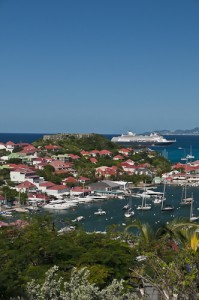Few of us probably could afford to live in postcard land
The middle of November is still well before the high season on St. Barts (also called St. Barths), which is one reason the Maasdam is able to tender us ashore and tie up at the postcard-sized cruise terminal at the mouth of Gustavia Harbor. Long and narrow St. Barts, just 8 square miles, is not a regular port of call for most cruise lines.
The reason: locals don’t want to be inundated by a lot of cruise passengers. The island’s narrow winding roads already are crowded enough. The idea of numerous large tour buses rounding the island every time a huge ship is in town is frightening. Not only to the locals but tourists like me who have driven those roads. This is why only relatively small ships like the Maasdam visit here and why the huge megaships likely never will.
Politically still a part of France, St. Barts is an island that seems to have built its tourism on a brilliant business model. Long ago those in power apparently decided the best way to differentiate St. Barts from the rest of the Caribbean was cater primarily to the wealthy and avoid trying to attract masses of tourists. The island has done this by charging prices only truly prosperous people can afford. Makes no difference whether St. Barts’ beaches are the best (they’re far better on neighboring Anguilla) or whether the island is tropical and lush (it’s so dry cactus thrive on St. Barts), the point is to make the island one of the Caribbean’s most exclusive. The Plan worked. With few commoners around to gawk at or pester them, the beautiful people were attracted to St. Barts, particularly media celebrities and rock stars.
Since mass tourism is not the main objective, St. Barts has no cruise dock. This is why we have to make a 15-minute tender trip from the Maasdam to Gustavia, capital of St. Barts. The trip ashore provides a good coastal overview and we arrive in Gustavia just before 9 a.m., about an hour after the Maasdam docked. At this “early hour,” few places are open for business. Restaurants serving breakfast are open, the tourist bureau with its plethora of information is open but many stores won’t start their day until 10.
The previous time Linda and I were here, we made the mistake of renting a car to see as much of the island as we could. The rental car was too much hassle, especially because of finding parking in Gustavia and the time-consuming process of pickup and drop-off. We did visit some other parts of the island but never saw as much as Gustavia as we wanted. This time we plan a leisurely, walking journey around Gustavia Harbor since we know we’ll back.
Well, not so leisurely at the start. The first thing we want to do is climb to a good overlook of Gustavia Harbor for photos. The maps from both the Maasdam and the local tourist bureau, strangely, do not contain all the streets we encounter as we transit the harbor. So we stop to ask a French couple in the process of opening their store.
Many from the U.S. might not expect the French on St. Barts to be very helpful since there is a decidedly negative stereotype of how the French behave towards Americans. Happily, the residents of St. Barts are naturally open and friendly to outsiders. That makes sense considering most of their exclusive clientele are from around the globe.
Still, in order to make bridging the anticipated language problem as painless as possible, I say “Pardon” to the couple. I point to Rue Thiers which the map indicates is well off to the left but should lead us to the Swedish bell tower, which I also point to on the map. Behind the bell tower is the iconic place for a panoramic shot of Gustavia Harbor.
The man responds in English. He admits, “I do no know the names of all the roads. What is it you are looking for?” I tell him, “The Swedish bell tower.”
He says, “Oh, then follow the road here going uphill.” The road we are standing on but which is not marked on either of our maps.
I thank him both in English and French. Then Linda and I trudge uphill, to the perfect viewpoint, which is the road just above the Swedish bell tower. There are higher elevations but trees block the harbor view.
(The background on St. Barts seems important to understand how the island works but it, has made this post waaay too long and I’ve hardly started. At the same time, it is necessary to appreciate Linda’s accompanying post about her shopping experience. The rest of our St. Barts day will have to wait for another time. It’s getting late and tomorrow we arrive in Martinique, where we take our first organized tour. Can’t be late for that!)


 Follow
Follow